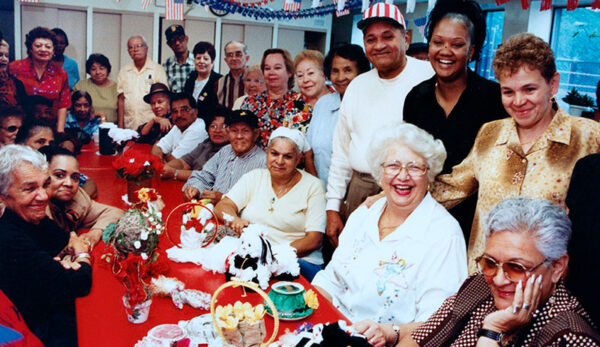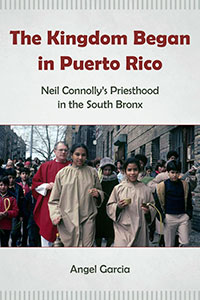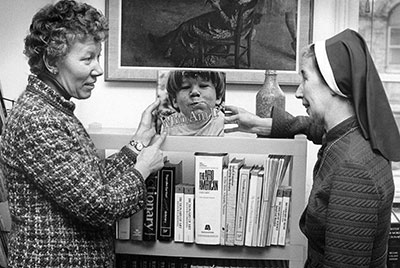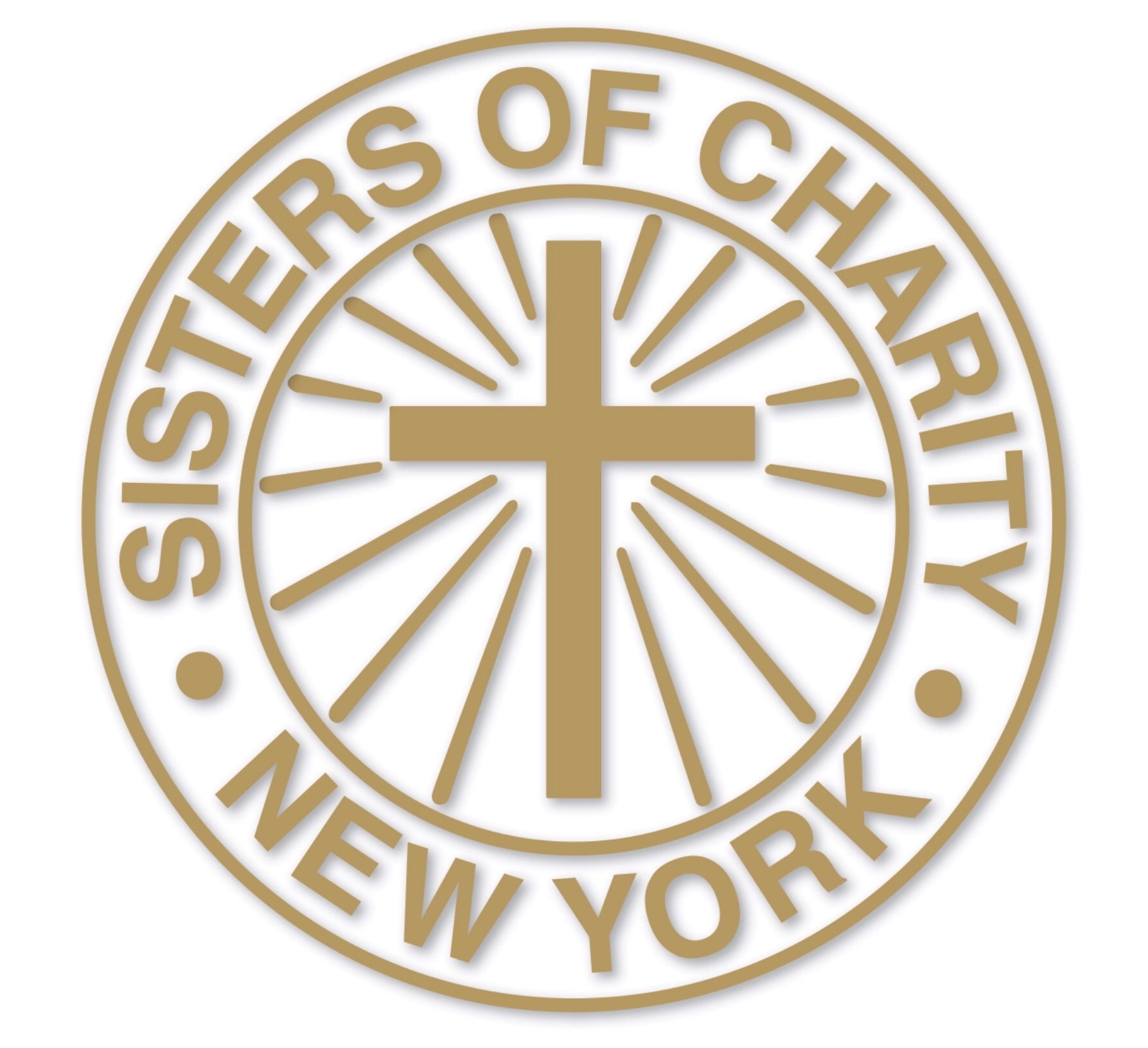By Regina Bechtle, SC

The Constitution of the Sisters of Charity calls us to recognize that “every Christian has a vocation to ministry” and to collaborate with others “to develop new channels to further the reign of God.” A recent book, The Kingdom Began in Puerto Rico: Neil Connolly’s Priesthood in the South Bronx (2021, Fordham University Press) documents the turbulent era of the 1960s to the 1980s through the lens of one dynamic priest-leader’s life and ministry. Author Angel Garcia, a long-term resident of the area, was an organizer with South Bronx People for Change, a group co-founded by Msgr. Connolly. In partnership with the priest and many others, Sisters of Charity worked to bring the area’s Catholics to claim their “vocation to ministry” and to create new ways for God’s dream to take flesh.’
Beginning in the 1880s, Sisters of Charity served the people of the South Bronx in parish schools such as St. Joseph, St. Augustine, St. Athanasius and Ss. Peter and Paul. The area was home to waves of immigrants from Ireland, Italy, Poland, Germany, Greece, Eastern Europe, Russia and other countries. After World War II, many Americans of Puerto Rican descent moved into the area, making the South Bronx one of the most culturally diverse areas of the country.

University Press
As later decades of decline, devastation, greed and governmental neglect re-shaped neighborhoods and wreaked havoc in residents’ lives, those who ministered there faced the challenge of uncovering new levels of St. Vincent de Paul’s proverbial “inventiveness to infinity.”
In the 1960s, Vatican Council II charted a new course for the Church in dialogue with the world and with real people’s joys and hopes, griefs and anxieties. As a young priest, Fr. Neil Connolly enthusiastically embraced the Council’s vision of a church that valued the gifts of the laity. After a summer in Puerto Rico learning Spanish, he was assigned to St. Athanasius parish on Tiffany Street in 1958 and began twenty-seven years of ministry among the large Puerto Rican community that had settled there.
Against the backdrop of one priest’s successes and struggles, this book documents the efforts of many laity, clerics and religious to respond with creative courage to the signs of the times. In doing so, they had to navigate secular and church powers. With St. Athanasius parish as a main hub, they battled massive social forces like drugs, crime, racism and income inequality, championed lay leadership, and expanded the scope of ministry. In these efforts, Sisters of Charity were key players.
Sisters Jeanne Atkinson, Margaret Beaudette, Elizabeth Butler, Thomas (Trudé) Collins, Maria Iglesias, Ann Marie Lafferty, Mary Liegey, Inez Mela, Maureen Moran, Rita Nowatzki, Ann Reynolds and Mary Sugrue, among others, taught in the school or worked in St. Athanasius parish. Although some were more visible and vocal than others, all in some way worked and advocated for social change.
Garcia notes, “Beginning in the 1960s they [the Sisters of Charity] were an active presence in Hunts Point-Longwood and became involved in services, in Summer in the City, and in the founding and growing of the SISDA and Seneca Center organizations.”

Staff Development, Archdiocese of New York speaks with Sr. Marie
Trinita Flood (right) ca. 1983
Summer in the City began in 1965 under the leadership of Msgr. Robert Fox, head of the Spanish Community Action Office in the Archdiocese of New York. Three principles guided the program: creativity, relationships and the public forum. It sought to address poverty and powerlessness by bringing people together in city streets and involving them in creative and fun activities that developed relationships and broke down barriers.
Sr. Margaret Dowling worked closely with Msgr. Fox; she arranged for sisters, even novices, to participate in Summer in the City in East Harlem and the South Bronx.
Sr. Ann Marie Lafferty began teaching at St. Athanasius in 1967 and in 1972 became its principal for the next 17 years. Over the years the school had developed a “strong reputation for quality education.” Sr. Ann Marie and her staff built on the firm foundation laid by her predecessor Sr. Rita Nowatzki and other sisters and lay teachers dating back to 1913. In the turbulent 70s and 80s, they soon became deeply involved with the people’s daily joys, struggles and realities.
Marianne Kraft succeeded Sr. Ann Marie as principal of St. Athanasius School. A former Sister of Charity, Marianne came there to teach English and art in 1972 and retired after 45 years of more-than-dedicated service. Interviewed by David Gonzalez, New York Times journalist who had attended the school in first grade, Marianne described the school as a “community of purpose” where “teachers who came here knew why they were here… These kids needed adults who would stand by them and who were not going to run away.”
Sisters Nora Cunningham and Muriel Long began a new model of team ministry with Fathers Robert Stern, Peter Gavigan and Neil Graham in Our Lady of Victory Parish. In 1977, at the request of lay leaders of parish groups, the team began offering courses in English and Spanish on Scripture, history of Christianity, Catholic teaching, communications, and leadership skills. The courses were so successful that the program soon grew into the South Bronx Pastoral Center that served the entire area, not just one parish. In its first year (1978–1979), the Center’s faculty of ten taught 129 students from seventeen parishes in the South Bronx and two in the North Bronx. Five years later, 38 courses were offered to 900 students; laypersons were among the faculty and on the Center’s board of directors and program advisory committee. Partnerships with the College of New Rochelle and Fordham University allowed graduates to enroll in adult education degree programs. As Fr. Stern later wrote, “[W]e believed that Church was primarily a matter of discipleship and that all its members were called to share in its mission and to serve. We had to help them become better disciples and better leaders.”
The South Bronx Pastoral Center “brought new possibilities to Puerto Rican laypersons wanting a leadership role in the Church of Vatican II.” It holds the distinction of being “the only comprehensive lay formation program in the United States” at the time, a fact well worth noting in contemporary American Catholic history.
Sr. Constance (Connie) Kelly collaborated with Fr. John Flynn of St. Francis of Assisi parish in the South Bronx to create the Bronx Heights Corporation, a community-based organization. She served in the parish from 1977 to 1981 and then became a missionary in Chile during the dangerous Pinochet years.
Sr. Trudé Collins is described in the history of the Sisters of Charity of New York as “beloved for the energy and charity she poured” for forty years into the South Bronx. She began as a teacher at St. Athanasius in 1962; five years later she transitioned into community organizing. From 1972 to 2004 she served as director of the Simpson Street Development Association (SISDA), a government-funded anti-poverty program with close ties to St. Athanasius. Sr. Trudé involved community members in shaping and benefiting from youth, job readiness, day care and parenting programs, and held SISDA to high standards of accountability—a key to its lasting success. For decades, Sr. Trudé co-led the South East Bronx Community Organization (SEBCO) founded by Rev. Louis Gigante to rebuild housing and strengthen community in Hunts Point-Longwood. In 2008, a 105-unit affordable housing building on Southern Boulevard was named “Sr. Thomas, SC, Apartments” in her honor. Unfortunately, Garcia’s book mentions her only briefly.
Vatican II broadened the vision of the Church’s meaning and mission in the world. With grit, guts and grace, the people and groups profiled in this book, including many Sisters of Charity, translated that vision of Church and laity into concrete, believable terms.
In 2015 when Msgr. Neil Connolly died, a newspaper tribute noted that he “lived to serve the community and believed in making leaders out of the people who lived there.” The same words could equally apply to Connolly’s colleagues and co-laborers, including the Sisters of Charity. Their passionate presence changed the face of the Church in the South Bronx. Their work, now largely carried on by dedicated lay persons, continues—not without struggle—to bear fruit.
Notes
- “Ministries,” 5.3
- Gaudium et Spes, Pastoral Constitution on the Church in the Modern World, Dec. 7, 1965, #1.
- p. 118. SISDA, or Simpson Street Development Association, began in 1964. Seneca Center was a parish community center.
- 113
- https://www.nytimes.com/2017/12/24/nyregion/south-bronx-side-street-marianne-kraft.html
- Garcia, 221
- SC History, vol. 6, p. 122
- https://cny.org/stories/sister-miriam-thomas-collins-sc,10884
- Earley, SC History vol. v, 315-316
- Garcia, 195
- Carmen Rios-Nuñez, 4.9.2017, https://huntspointexpress.com/2017/04/09/monsignor-neil-connolly-former-priest-of-st-athanasius-church-and-longtime-activist-dies-at-83/

“El Zorro” was my parish priest at St Ann’s on 12th St in Manhattan way, way back in the day before he became Monsignor.
He and my parents worked to establish ‘Summer in the City’ in St Brigid’s Parish in the Lower East Side of Manhattan. Our apartment became headquarters for a while in the Lillian Wald Projects.
Fox loved God and he shared that love with everyone he knew. Thank you for remembering his work as head of Spanish Affairs for the Archdiocese.
I remember them all. I was shocked that Sister Thomas was not mention. She worked hard for the SISDA program and Erma Cava seniors. I was a member of South Bronx People for Change and I am honored to have worked under the leadership of Father Connelly and Angel Garcia.